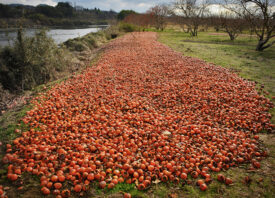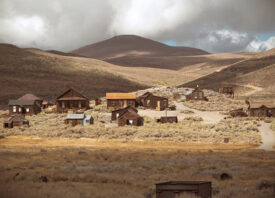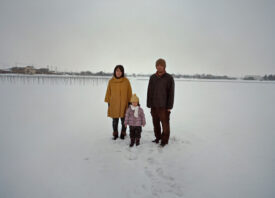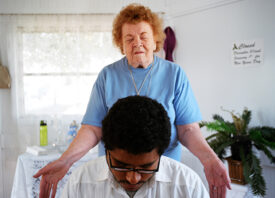Search this site
Former Residents of a Fukushima Ghost Town Return Home in Emotional Photo Series

Katsuyuki Yashima is sitting in his own workshop. At the time of the accident, he and his wife employed 15 people. His company will not reopen, and he does not think they will go back to live in Namie even after the city reopened. “I will not go back because I can not restart my business. In 10 years, Namie will be a ghost town. According to a survey, only 20% of the inhabitants of Namie want to come back. Gradually, as the years pass, people will rebuild their lives elsewhere, and in the end, no one will return.” Katsuyuki Yashima lives in Iwaki city, where the level of radioactivity is very low.

Midori Ito is in an abandoned supermarket in Namie. Here, nothing has changed since the disaster. On a panel, you can even read the words “Fresh produce” in Japanese. Just after the disaster, Midori Ito evacuated to Minami Aizu because of health risks associated with radioactivity. She finally returned to live with her children in the city of Koriyama, situated about 60 km from the plant.
In town of Namie in Fukushima, Japan, a girl poses in a school gym; outside of the frame of French photographers Carlos Ayesta and Guillaume Bression, her mother is weeping. It’s a place they once knew well and perhaps even took for granted, but in the years following the nuclear disaster, the tsunami, and the earthquake, it has fallen into ruins.
As part of their extensive documentation of Fukushima’s exclusion zone, Ayesta and Bression asked former residents of Namie, now considered by many to be a “ghost town,” to return to the places they once knew inside and out: their places of work, their regular stores, their daily haunts and hangouts.
For Retrace Our Steps, they not only cleared the physical obstacles imposed by the Japanese government but also the emotional barriers built up by their subjects. They spent a great deal of time— four years— shooting in the area, and although sometimes they were able to reach out through mutual contacts, but they also found former residents through the clues they left behind.
Convincing the inhabitants of Namie to return took time and trust, but those who chose to participate invested fully in the process. They opened up about their memories, their dreams and fears about the possibility of returning someday.
Ayesta and Bression asked that they sit how they would have years earlier, before the catastrophe, when daily life lumbered on as usual. It was a process, says Ayesta, of “reconstituting normal life in chaos,” a “life will never be the same as before.”
Each time these people visit their former homes, they have fallen more deeply into disrepair. It rains, and rodents have taken over many of the facilities. One farmer interviewed by the photographers came back to see his cows dead, reduced to skeletons.
For all the people they were able to track down, the photographers also understand that some stories can never be told. One place has remained imprinted Ayesta’s mind: an old railway station with a lone car on the tracks. Says the artist, “The car probably had a owner who died. The car changes and stays here. Each time went back, each time the car was there, like a testimony of the dead.”
Carlos Ayesta and Guillaume Bression’s work from Fukushima is now on view at the Centre d’art de Moulinsart as part of Les Photographiques. It will also visit Chanel Nexus Hall in Tokyo beginning June 24th.

Setsuro Ito is a vet. He takes care of animals, especially cows living in the prohibited zone. Here, he is sitting in a bar. He left Japan to live in Brazil when he was 30 years old, but after March 11, he decided to return to his country to help farmers in the exclusion zone who decided not to slaughter their livestock. He now lives in Fukushima city.

Kanoko Sato is in a gymnasium of a school in the Ukedo district, destroyed by the tsunami and left like this since the disaster. “If it was not for this project, I would never have seen this forbidden zone with my own eyes. Even though I live in Koriyama and that is close enough, I did not know how badly this place was devastated until today “

Rieko Matsumotoest is in a laundry Namie. She is a nutritionist and counselor. “The day of the earthquake, I was working with a Philippine client who was there for his first time. I was ready to measure parts of her body, and she was about to take off her clothes when the ground started shaking. She spoke to me in Japanese up until that very moment, but when it hit, she suddenly started shouting in English.”

Naoto Matsumura is an inhabitant of Tomioka city. Employed in a construction company before the accident, he finally decided to return lived in the exclusion zone to take care of animals left to abandoned after the nuclear disaster. He is one of the few inhabitants to refuse to abide by the government’s evacuation order. Here, he is in a stable where hundreds of abandoned cows died in their stalls after the accident. Today, he looks after the animals in the area thanks to the donations he receives.

Shigeko Watanabe ran a small printing company in the city center of Namie. She will never reopen her business. “I personally think that decontamination is meaningless because no one will come back here anyway. Only the men say they will return but us women are stronger than them and manage to face the truth head-on. The government strongly urges us to prepare to return, but to me, the town of Namie will be destroyed.”

Hidemasa and Michiko Otaki are in their old air dresser shop in Tomioka, a town hit hard by the tsunami and evacuated following the nuclear accident. She practiced this profession for 40 years. “I had just finished a cut when the earthquake took place. After the accident, we moved from shelter to shelter, I started cutting hair for the other refugees. One day, I was talking with another refugee, and she told me that a house was free 40 km south of the plant. This is where I have lived for over 2 years now.”

Yasushi Ishizuka is in a Japanese playroom in Tomioka city. The building was heavily affected by the earthquake and has remained abandoned since the disaster.

Kazuhiro Onuki is in his old house in Tomioka. Before the accident, he managed bookstore and also had a Japanese ceramics shop. He got robbed several times as a result of the accident, and all the valuable pieces disappeared. We wanted to photograph him in his house. This room pretty much captures the atmosphere of his abandoned house today. Kazuhiro Onuki evacuated into the Tokyo area with his wife and daughter. He regularly participates in conferences where he is invited to talk about his experience of the nuclear disaster. Even if he returns occasionally to clean his house, he will not return here to live.
All images © Carlos Ayesta and Guillaume Bression



